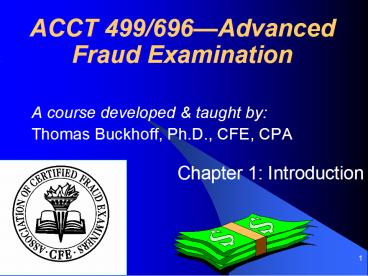ACCT 499696Advanced Fraud Examination - PowerPoint PPT Presentation
1 / 31
Title:
ACCT 499696Advanced Fraud Examination
Description:
Learned from intimate personal groups. 6. Donald R. Cressey ... Older tend to occupy higher ranking positions. Greater access to revenues, assets, resources ... – PowerPoint PPT presentation
Number of Views:195
Avg rating:3.0/5.0
Title: ACCT 499696Advanced Fraud Examination
1
ACCT 499/696Advanced Fraud Examination
- A course developed taught by
- Thomas Buckhoff, Ph.D., CFE, CPA
- Chapter 1 Introduction
2
Defining Fraud
- The use of ones occupation for personal gain
through the deliberate misuse or theft of the
employing organizations resources or assets.
3
Defining Abuse
- A deceitful act
- A corrupt practice/custom
- Examples
- Borrow company equipment
- Use sick leave when not sick
- Slow or sloppy work
- Surf the Net at work
- Work under influence of drugs/alcohol
4
Research in Occupational Fraud and Abuse
- Sutherland
- Cressey
- Albrecht
- Hollinger
- Wells Report
5
Edwin H. Sutherland
- First defined white-collar crime
- Criminal acts of corporations and individuals
acting in their corporate capacity - Theory of differential association
- Crime is learned
- Not genetic
- Learned from intimate personal groups
6
Donald R. Cressey
- His idea of a corporate cop was the catalyst
for the ACFE. - Research focused on the offenders rather than the
victims. - Created a theory for explaining white collar
criminal behavior.
7
Cresseys Hypothesis (1953)
- Trusted persons become trust violators when they
conceive of themselves as having a financial
problem which is nonsharable, are aware this
problem can be secretly resolved by violation of
the position of financial trust, and are able to
apply to their own conduct verbalizations which
enable them to adjust their conceptions of
themselves as trusted persons with their
conceptions of themselves as users of the
entrusted funds or property.
8
The Fraud Triangle
PRESSURE
RATIONALIZATION
PERCEIVED OPPORTUNITY
9
Nonsharable Problems
- Violation of ascribed obligations (i.e.
inability to pay ones debts) - Personal failures (i.e. vices)
- Business reversals (cant walk away)
- Physical isolation (no one to help)
- Status gaining/maintenance
- Strained employer-employee relations
10
Cresseys Offender Types
- Independent businessmen
- Borrowing
- Funds really theirs
- Long-term violators
- Borrowing
- Protect family from shame or poverty
- Company cheating them
- Company generally dishonest
11
Cresseys Offender Types
- Absconders
- Take the money and run
- Usually unmarried, loners
- Blame outside influences or personal defects
12
W. Steve Albrecht
- Nine motivators of fraud
- Living beyond means
- Overwhelming desire for personal gain
- High personal debt
- Close association with customers
- Inadequate compensation
13
W. Steve Albrecht
- Nine motivators of fraud
- Wheeler-dealer
- Strong challenge to beat system
- Excessive gambling
- Family/peer pressure
14
The Fraud Scale
- Situational pressures
- Immediate problems with environment
- Usually debts/losses
- Perceived opportunities
- Poor controls
- Personal integrity
- Individual code of behavior
15
The Fraud Scale
16
Richard C. Hollinger
- Hollinger-Clark study (1983)
- Surveyed 10,000 workers
- Theft caused by job dissatisfaction
- True costs vastly understated
17
Hollingers Conclusions
- Employee perception of controls is important
- Increased security may hurt, not help
- Employee-thieves exhibit other deviance
- Sloppy work, sick leave abuses, etc.
- Hydraulic effect
- Management should be sensitive to employees
- Pay special attention to young employees
18
Hollingers Conclusions
- Four key aspects of policy development
- Understand theft behavior
- Spread positive info on company policies
- Enforce sanctions
- Publicize sanctions
19
The Report to the Nation on Occupational Fraud
and Abuse(a.k.a. The Wells Report)
- Largest fraud study ever
- Study of 2,608 fraud cases
- Reported by CFEs
- Total 15 billion in losses
- 22 to 2.5 billion
- Cases from text come from this study
20
Position in the Organization - Cases
21
Position in the Organization Median Loss
22
Median Loss by Gender
23
Median Loss by Age
- Direct and linear correlation between age and
median loss - Older tend to occupy higher ranking positions
- Greater access to revenues, assets, resources
5
24
Median Loss by Age
25
Median Loss by Marital Status
26
Median Loss by Education
27
Median Loss Per Number of Employees
28
Classifying Occupational Fraud and Abuse
29
Number of Casesby Scheme Type
30
Median Loss by Scheme Type
31
Fraudwise
- Specializing in fraud detection, investigation,
and prevention consulting services - Senior Consultant
- Thomas Buckhoff, Ph.D., CFE, CPA
- 2974 Southgate Drive
- Fargo, ND 58103-3524
- 701-231-8512
- www.fraud-wise.com































